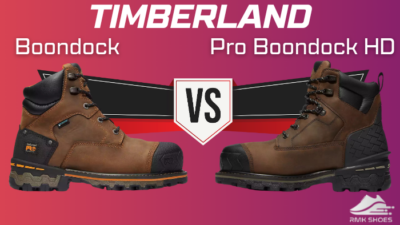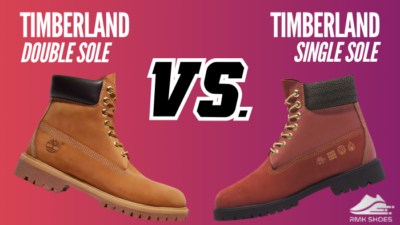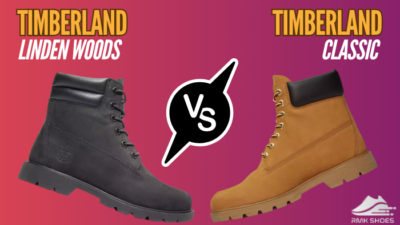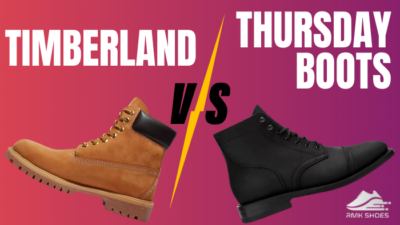As a dedicated runner, I always look for the perfect pair of running shoes to enhance my performance and comfort.
Today, I am thrilled to compare two highly acclaimed running shoe models: the Nike Pegasus 40 and the Nike Zoom Fly 5.
These shoes have garnered attention for their cutting-edge technologies and exceptional features that cater to the needs of runners.
In today’s article, I’ll explore the features and characteristics that set the Nike Pegasus 40 and the Nike Zoom Fly 5 apart, exploring their unique qualities and capabilities.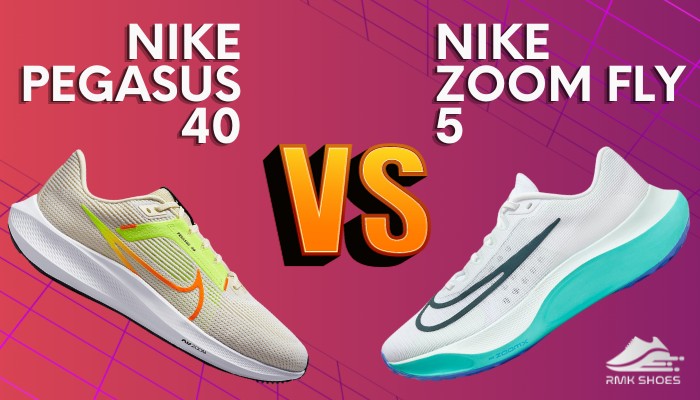
So, let’s start the head-to-head comparison between Pegasus 40 and Nike Zoom Fly 5.
Overview of Nike Pegasus 40 and Nike Zoom Fly 5
When it comes to top-tier athletic footwear, Pegasus 40 and Zoom Fly 5 stand out in the crowd.
The Nike Pegasus 40 epitomizes versatility, combining style and function seamlessly.
Conversely, the Nike Zoom Fly 5 is a speedster’s dream, designed for those who crave precision and explosive energy.
Nike Pegasus 40
The Nike Pegasus 40 continues the legacy of the renowned Pegasus series, embodying a versatile design catering to various running preferences.
Pegasus 40 builds on the success of its predecessors with a neutral profile, 10mm drop, and 31mm of cushioning at the heel.
Its midsole incorporates Nike’s signature React Foam, offering a smooth and cushioned ride, enhanced by an Air Zoom unit for responsive support during each stride.
The shoe’s engineered mesh upper ensures breathability and a snug fit, making it an ideal choice for daily training, long-distance runs, and even some races.
Nike Zoom Fly 5
In contrast, the Nike Zoom Fly 5 represents a departure from its earlier iterations, introducing a fresh approach to maximalist running.
While its predecessors, like the Zoom Fly 4, garnered attention for their unique design and Zoom X foam, the Zoom Fly 5 leaps forward.
A significant departure from the traditional Zoom Fly line, it incorporates a combination of recycled Zoom X foam and SRO2 EVA foam in the midsole, providing both comfort and durability.
With a substantial 40mm stack height at the heel and an 8mm drop, the Zoom Fly 5 is a training-centric shoe focusing on efficiency during steady-state tempo runs.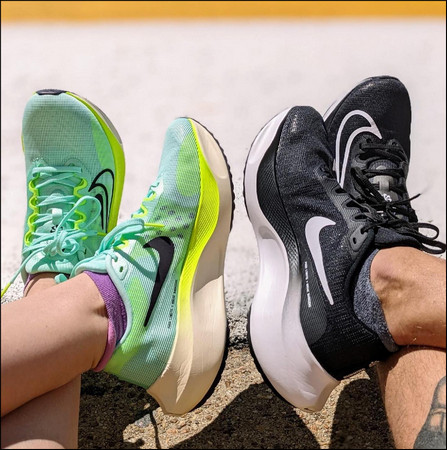
The Pegasus 40 and Zoom Fly 5 cater to distinct preferences within the running community.
While the Pegasus series has long been revered for its all-encompassing capabilities, the Zoom Fly 5 takes a bolder step toward maximal cushioning, promising durability alongside its unique design.
Let’s dig deeper into the specifics of each, examining their features, performance attributes, and notable differences.
Feature Comparison of Nike Zoom Fly 5 and Nike Pegasus 40
Nike Zoom Fly 5 and Nike Pegasus 40 are two popular running shoes from Nike’s extensive lineup. While designed for running, they both have distinct features that cater to different types of runners.
Let’s look at the shoe’s features, key specifications, and characteristics to determine which is best for you.
| Feature | Nike Zoom Fly 5 | Nike Pegasus 40 |
|---|---|---|
| Type | Neutral Running Shoe | Neutral Running Shoe |
| Upper Material | Dual-layer upper with waxy-feel mesh knit material | Engineered Mesh |
| Midsole | Combination of recycled Zoom X foam and SRO2 EVA foam | Nike React Foam with Zoom Air unit in the forefoot |
| Outsole | Thick rubber at the front (forefoot) and back (heel) | Durable rubber with varied traction patterns |
| Stack Height | 40mm (heel), 32mm (forefoot) | Approximately 31mm (heel), 21mm (forefoot) |
| Drop | Approximately 8mm | Around 10mm |
| Weight (men's 10) | 314 g or 11 oz | 288 g or 10.2 oz |
| Durability | Emphasizes durability with an additional outer foam layer | Good durability with durable rubber outsole |
| Sizes | True to size | True to size |
| Available Widths | Standard | Regular and extra |
| Stability | Ideal for neutral and overpronating runners | Suitable for neutral runners |
| Price | $160 | $130 |
| Notable Features | Zoom X foam, redesigned from previous Zoom Fly models | Air Zoom unit for responsive cushioning |
| Ideal Use | Training runs, steady-state tempo runs, less for racing | Versatile - daily training, medium runs |
This table summarizes the essential details of the Nike Pegasus 40 and Nike Zoom Fly 5. This also provides a concise overview to facilitate a comprehensive comparison in the upcoming section.
Primary Differences between Nike Pegasus 40 and Nike Zoom Fly 5
Nike Pegasus 40 and Zoom Fly 5 represent the epitome of athletic innovation. While Pegasus 40 offers an all-encompassing experience, Zoom Fly 5 targets the need for speed.
Together, they define Nike’s commitment to pushing the boundaries of performance footwear.
Here are the main differences between the Nike Pegasus 40 and the Nike Zoom Fly 5:
1. Design & Style
The Pegasus 40 boasts a sleek and modern design, merging simplicity with functionality. The upper showcases a refined mesh, providing a clean and breathable aesthetic.
The traditional tongue design and webbing lacing system offer a classic yet practical look.
Also, the heel counter is stable without compromising style.
In contrast, the Zoom Fly 5 departs from convention, featuring a more pronounced and maximalist design. The upper adopts a multi-layered approach with a unique mesh knit, offering a bold visual statement.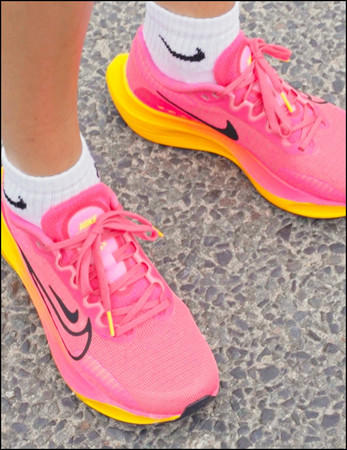
The absence of a traditional tongue and the introduction of a distinct lacing system similar to the Pegasus 40’s webbing system contribute to its avant-garde appearance.
The heel counter embraces a simplified style, aligning with its focus on maximal cushioning.
The Nike Zoom Fly 5 design is something I find personally appealing.
2. Overall Materials
Materials in Pegasus 40
- Upper: Engineered mesh
- Midsole: React Foam with an Air Zoom unit in the forefoot and heel
- Outsole: Rubber
The Pegasus 40 boasts a thoughtful combination of materials designed to elevate performance. Its upper, engineered from breathable mesh, balances lightweight comfort and structural integrity.
Including an Air Zoom unit in the midsole (forefoot & heel) enhances responsiveness and cushioning. This contributes to a dynamic and supportive running experience.
The midsole is crafted from Nike’s renowned React Foam, whereas the outsole is made of durable rubber, enhancing traction and resilience for extended wear.
Materials in Zoom Fly 5
- Upper: Dual-layered knit upper
- Midsole: Recycled Zoom X Foam, SRO2 EVA Foam with Carbon Plate
- Outsole: Rubber
Breaking tradition, the Zoom Fly 5 introduces a distinctive composition of dual-layer upper with waxy-feel mesh knit material.
Also, in the midsole, the Fly 5 incorporates recycled Zoom X foam to enhance sustainability, while SRO2 EVA foam provides structural support.
The midsole also features a carbon plate, enhancing responsiveness and energy transfer. Its outsole, constructed with robust forefoot and heel rubber, ensures longevity and reliable traction.
The Pegasus 40’s Air Zoom unit is a game-changer for me. The responsive cushioning it provides makes my runs feel like a breeze.
However, material-wise, the Nike Zoom Fly 5 has some distinctive advantages over the Pegasus 40.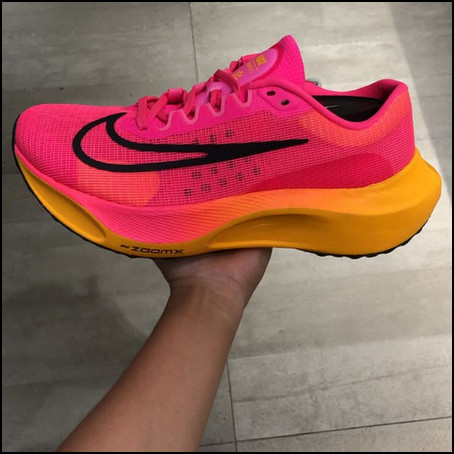
3. Comfort and Cushioning
Sliding into the Pegasus 40 reveals a comforting embrace. The React Foam midsole and the Air Zoom unit deliver a plush and responsive cushioning experience.
Also, the engineered mesh upper provides a snug fit without compromising breathability during runs.
The Pegasus 40 balances comfort and performance, making it an ideal choice for various distances.
Meanwhile, Nike Zoom Fly 5 places a strong emphasis on maximal cushioning. Its combination of recycled Zoom X foam and SRO2 EVA foam creates a pillowy sensation underfoot.
While it may add weight, the comfort derived from this maximalist approach is notable. The unique midsole composition contributes to a smooth and supportive ride, making the Zoom Fly 5 suitable for those prioritizing cushioning during training sessions.
Regarding comfort, the Pegasus 40 stands out with its Air Zoom unit. The plush and responsive feel during runs is unmatched.
4. Weight and Efficiency
When it comes to the weight and efficiency of the Nike Pegasus 40 and the Nike Zoom Fly 5, my experiences have been notably distinct.
The Pegasus 40 is a moderately weighted shoe for everyday training and versatility. It weighs 10.2 oz, which provides a balanced feel during runs.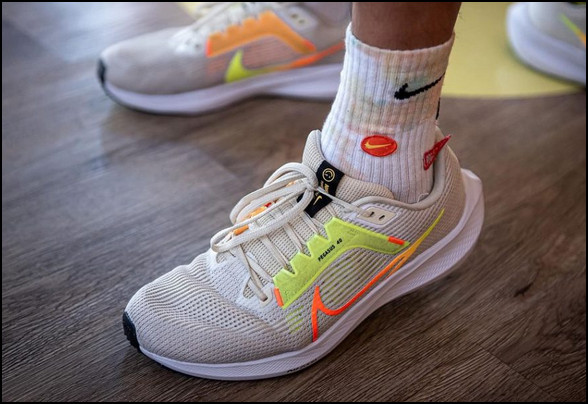
This shoe is also efficient for various workouts, making it a reliable choice for regular training sessions.
On the other hand, the Zoom Fly 5 departs from the conventional lightweight design.
While its weight is slightly heavier (11 oz), the efficiency of this shoe shines in its responsiveness and forward propulsion.
Including a carbon plate in the midsole contributes to a distinctive efficiency, pushing the boundaries to achieve faster paces.
While the Pegasus 40 excels in everyday comfort and versatility, the Zoom Fly 5 prioritizes efficiency and speed.
While the Zoom Fly is heavier than the Pegasus 40, the technology it incorporates makes it more efficient and forgiving for the weight.
5. Performance
The Pegasus 40, with its versatile design, excels in delivering a well-rounded performance for everyday training. Its cushioned react foam midsole, incorporating Air Zoom units, provides a plush and comfortable ride suitable for various distances.
While it may lack the aggressive responsiveness of a racing shoe, it compensates with reliable comfort and stability.
Conversely, the Zoom Fly 5 is a performance-oriented shoe that leans heavily towards speed and efficiency.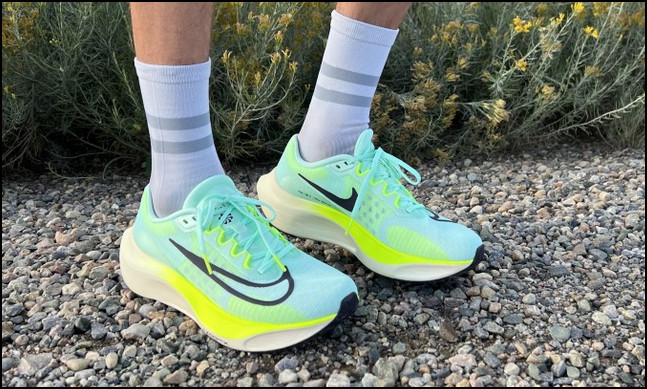
Including a carbon plate in the midsole contributes to heightened responsiveness, propelling each stride forward with purpose.
While sacrificing some of the day-to-day comforts in the Pegasus 40, this design is geared toward those seeking enhanced performance during tempo runs, races, or speed-focused workouts.
The Pegasus 40 is a reliable workhorse for everyday training and prioritizes comfort, while the Zoom Fly 5 is a performance-driven shoe tailored for those aiming to push their pace boundaries.
6. Intended Use
In terms of intended use, the Nike Pegasus 40 and Nike Zoom Fly 5 are ideal for different scenarios.
The Nike Pegasus 40 is a versatile running shoe suitable for various running activities, from daily training runs to longer-distance races.
Pegasus 40 offers a balanced combination of cushioning, support, and responsiveness. These qualities make it a solid choice for runners seeking comfortable and reliable shoes for regular training sessions.
In contrast, the Nike Zoom Fly 5 is more notable for speed-oriented runners or individuals like me who want to improve their performance.
The shoe emphasizes responsiveness and propulsion to help you achieve faster speeds and reach new personal bests.
However, the Zoom Fly 5 is less comfortable or supportive for long training runs than the more versatile Nike Pegasus 40.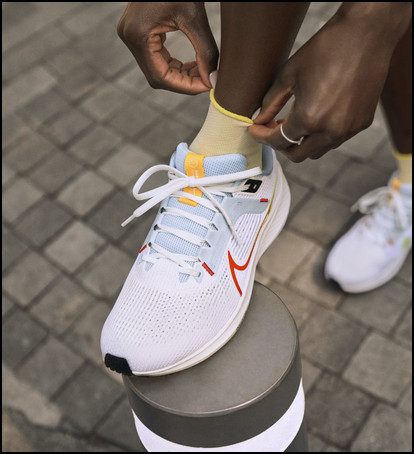
Nike Pegasus 40 is a well-rounded running shoe suitable for various running activities. Meanwhile, the Nike Zoom Fly 5 is specifically designed for speed-focused runners.
7. Size & Fit
Both the Nike Pegasus 40 and Zoom Fly 5 are true to size.
From my fitting experience, the Pegasus 40 maintains a true-to-size fit, hugging the foot comfortably with ample space in the toe box. Also, Pegasus 40 offers regular and broader widths on the website.
Therefore, if you have a wider foot, you can easily grab the true size with a wider width.
Conversely, the Zoom Fly 5 leans slightly towards a snug fit that ensures a secure lockdown to enhance performance.
I find that a good choice cause it’s a performance shoe, and I need it to fit comparatively tight when I need to push my pace.
However, Zoom Fly 5 doesn’t offer wider choices, so if you have a more comprehensive fit, sizing up half is necessary.
Also, its snug fit, especially around the midfoot, contributes to stability during faster-paced runs but requires attention to sizing nuances.
I absolutely loved the snug and secure fit the Zoom Fly 5 provided.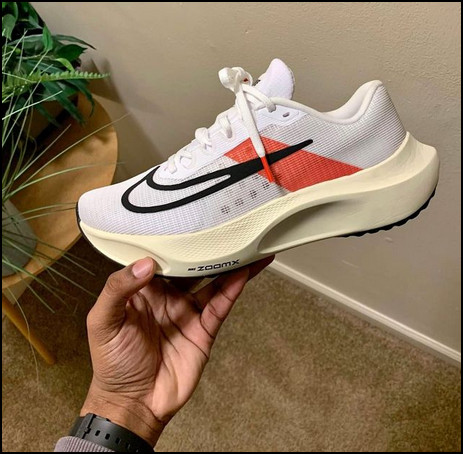
The Pegasus 40 offers a budget-friendly entry into high-performance running and costs $130. This makes it an accessible choice for runners looking for quality without breaking the bank.
In contrast, the Zoom Fly 5 commands a slightly higher price tag of $160, justifiable for its unique materials and specialized design.
Moreover, when it comes to longevity, the Pegasus 40 stands out.
Its robust construction and proven track record in previous iterations promise a reliable companion for the miles ahead.
The Zoom Fly 5, though durable, might experience slightly more wear due to its lighter construction and experimental materials.
Pros and Cons of Nike Pegasus 40 and Nike Zoom Fly 5
Picking between the Pegasus 40 and Zoom Fly 5 isn’t about which shoe is faster. It’s about understanding your running rhythm. The Pegasus hums a steady, comfortable tune while the Zoom Fly blasts a high-tempo performance anthem.
Here are the benefits and drawbacks of the Nike Pegasus 40 and Nike Zoom Fly 5:
Nike Pegasus 40
- »Improved upper comfort.
- »Highly durable outsole.
- »Affordable Price.
- »Good lockdown.
- »Stable ride.
- »No energy return.
- »Weight has increased over the Pegasus 39.
Nike Zoom Fly 5
- »Highly cushioned midsole.
- »Carbon plate for propulsion.
- »More stable than previous versions.
- »Modern and futuristic style.
- »Good traction.
- »More expensive than Pegasus 40.
- »It has a heavier and stiffer design than the Pegasus 40.
Nike Pegasus 40 vs. Nike Zoom Fly 5: Which One is Better?
Declaring a definitive victor in the Nike Pegasus 40 vs. Nike Zoom Fly 5 clash would be a disservice to their distinct strengths. Both cater to specific needs and thrive in different running ecosystems.
The Nike Pegasus 40 offers a balanced blend of cushioning and responsiveness, making it an ideal choice for daily training and long-distance runs.
It combines React and Cushlon foam in the midsole, providing a comfortable and supportive ride. Also, Pegasus 40 suits neutral runners seeking a reliable all-around shoe.
On the other hand, the Nike Zoom Fly 5 is geared towards speed and racing performance. Its lighter weight, Zoom Air unit in the midsole, and carbon fiber-infused rubber outsole offer enhanced responsiveness and energy return.
The Zoom Fly 5 suits neutral runners and those who overpronate, providing stability while focusing on faster-paced runs.
Mentioning all the above, if you prioritize comfort, mileage, and durability, the Nike Pegasus 40 is an ideal choice for you.
Or, if you crave exhilarating speed and performance, the Nike Zoom Fly 5 is a better choice.
FAQs
Are Nike Pegasus 40 good for running?
Yes, the Nike Pegasus 40 is a good choice for running. It offers a combination of cushioning and durability, making it suitable for neutral runners looking for versatile and comfortable running shoes.
What are Nike Zoom Fly 5 suitable for?
The Nike Zoom Fly 5 is ideal for runners seeking a lightweight, responsive shoe for speed and efficiency. It excels in providing a propulsive and energetic ride, making it an excellent option for casual runners and competitive athletes.
Is Nike Pegasus 40 durable?
The Nike Pegasus 40 is designed with durability in mind. Its durable rubber outsole provides excellent traction and withstands regular wear and tear. Additionally, the shoe’s construction ensures longevity even with consistent use.

